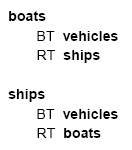4. Semantic Relationships used in Controlled Vocabularies
4.1 Semantic Linking | 4.2 Equivalency | 4.3 Hierarchy | 4.4 Associative
4.4 Associative Relationships (8.4)
This relationship covers associations between terms that are neither equivalent nor hierarchical, yet
the terms are semantically or conceptually associated to such an extent that the link between them
should be made explicit in the controlled vocabulary, on the grounds that it may suggest additional
terms for use in indexing or retrieval. The relationship is symmetrical, and is generally indicated by
the abbreviation RT (related term).
Example 114: Associative relationship notation (RT)
cells
RT cytology
cytology
RT cells
The associative relationship is the most difficult one to define, yet it is important to make explicit the
nature of the relationship between terms linked in this way and to avoid subjective judgments as
much as possible; otherwise, RT references could be established inconsistently.
As a general guideline, whenever one term is used, the other should always be implied within the
common frames of reference shared by the users of the controlled vocabulary. Moreover, one of the
terms is often a necessary component in any explanation or definition of the other; the term cells, for
example, forms a necessary part of the definition of cytology.
Either of the following types of terms can be linked by the associative relationship:
a) those belonging to the same hierarchy
b) those belonging to different hierarchies
4.4.1 Relationships Between Terms Belonging to the Same Hierarchy (8.4.1)
Relationships are needed for terms belonging to the same hierarchy in various special situations,
primarily to guide the user in locating the desired term.
4.4.1.1 Relationships Between Overlapping Sibling Terms
Related Term (RT) references are required for sibling terms with overlapping meanings, such as
ships and boats, where each of the terms can be precisely defined (so they do not form an
equivalence set), yet they are sometimes used loosely and almost interchangeably. The user
interested in one should be reminded of the other.
In the systematic section of a controlled vocabulary containing organized hierarchies (see 5.3.4), the method of display will bring the Related Term references together. The relationship
should be indicated explicitly, however, in an alphabetical listing and in the alphabetic section of a
hierarchical controlled vocabulary.
Example 115: Overlapping sibling terms hierarchical display

Example 116: Overlapping sibling terms alphabetical display

4.4.1.2 Relationships Between Mutually Exclusive Sibling Terms
It is not necessary to interrelate all sibling terms. For example, there is no need to associate terms
such as roses and daffodils, which share the broader term flowers, because the meaning of the
terms does not overlap, i.e., they are mutually exclusive.
4.4.2 Relationships Between Terms Belonging to Different Hierarchies (8.4.2)
It is possible to establish many grounds for associating terms belonging to different hierarchies.
Related Term references are often made between etymologically related terms, i.e., that contain the
same root, but which do not represent the same kind of thing. The following are some representative
examples of typical relational situations. For guidance on coding the precise nature of a relationship,
see Z39.19 section 8.4.4. The following examples illustrate the types of associative relationships listed in
Table 1 of 4.1.
Example 119: Process / Agent associative relationships
temperature control
RT thermostats
thermostats
RT temperature control
hunting
RT hunters
hunters
RT hunting
Example 120: Process / Counteragent associative relationships
fire
RT flame retardant
flame retardant
RT fire
inflammation
RT anti-inflammatory agents
anti-inflammatory agents
RT inflammation
Example 121: Action / Property associative relationships
environmental cleanup
RT pollution
pollution
RT environmental cleanup
polling
RT public opinion
public opinion
RT polling
Example 122: Action / Product associative relationships
weaving
RT cloth
cloth
RT weaving
lacrimation
RT tears
tears
RT lacrimation
Example 123:Action / Target associative relationships
harvesting
RT crops
crops
RT harvesting
binding
RT books
books
RT binding
Example 124: Cause / Effect associative relationships
death
RT bereavement
bereavement
RT death
pathogens
RT infections
infections
RT pathogens
Example 125: Concept or Object / Property associative relationships
poisons
RT toxicity
toxicity
RT poisons
liquids
RT surface tension
surface tension
RT liquids
Example 126: Concept or Object / Origins associative relationships
beluga caviar
RT Caspian Sea
Caspian Sea
RT beluga caviar
Socratic method
RT Greek civilization
Greek civilization
RT Socratic method
Example 127: Concept or Object / Units or Mechanisms of Measurement associative relationships
electric current
RT amperes
amperes
RT electric current
temperature
RT thermometers
thermometers
RT temperature
Example 128: Raw Material / Product associative relationship
wheat
RT flour
flour
RT wheat
graphite
RT lubricant
lubricant
RT graphite
Example 129: Discipline or Field / Object or Practitioner associative relationships
mathematics
RT mathematicians
mathematicians
RT mathematics
neurology
RT nervous system
nervous system
RT neurology
botany
RT plants
plants
RT botany
4.4.3 Node Labels for Related Terms (8.4.3)
In order to bring closely related concepts together in the alphabetical array under a given term,
related terms may be divided into categories that do not form part of a logical hierarchy. These
related terms should then be identified by a node label.
Example 132: Node labels for related terms

In this example, [operations] functions as a node label that describes a category or facet to which the
related terms belong. Node labels used with narrower terms generally describe a characteristic or sub-division.
4.4.4 Specifying Types of Related Term References (8.4.4)
In certain controlled vocabularies, it may be considered desirable to refine Related Term references
in order to make the nature of the relationships explicit.
Codes for such relationship indicators and their reciprocals may be developed locally. These local
codes should be clearly explained and illustrated in the introduction or documentation of the
published or machine-readable controlled vocabulary.
| Table of Contents |
| 1. Why Vocabulary Control | 2. Principles | 3. Structures | 4. Semantic Relationships |
| 5. Displays | 6. When to use | 7. Examples of use | 8. About Z39.19 |
©NISO, 2005 http://www.niso.org/
Source: Based on ANSI/NISO Z39.19-2005 ISBN: 1-880124-65-3
Guidelines for the Construction, Format, and Management of Monolingual Controlled Vocabularies


